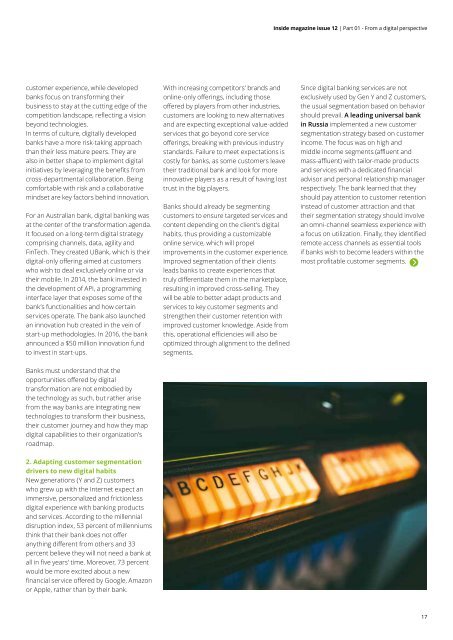lu_inside12-full
Create successful ePaper yourself
Turn your PDF publications into a flip-book with our unique Google optimized e-Paper software.
Inside magazine issue 12 | Part 01 - From a digital perspective<br />
customer experience, while developed<br />
banks focus on transforming their<br />
business to stay at the cutting edge of the<br />
competition landscape, reflecting a vision<br />
beyond technologies.<br />
In terms of culture, digitally developed<br />
banks have a more risk-taking approach<br />
than their less mature peers. They are<br />
also in better shape to implement digital<br />
initiatives by leveraging the benefits from<br />
cross-departmental collaboration. Being<br />
comfortable with risk and a collaborative<br />
mindset are key factors behind innovation.<br />
For an Australian bank, digital banking was<br />
at the center of the transformation agenda.<br />
It focused on a long-term digital strategy<br />
comprising channels, data, agility and<br />
FinTech. They created UBank, which is their<br />
digital-only offering aimed at customers<br />
who wish to deal exc<strong>lu</strong>sively online or via<br />
their mobile. In 2014, the bank invested in<br />
the development of API, a programming<br />
interface layer that exposes some of the<br />
bank’s functionalities and how certain<br />
services operate. The bank also launched<br />
an innovation hub created in the vein of<br />
start-up methodologies. In 2016, the bank<br />
announced a $50 million innovation fund<br />
to invest in start-ups.<br />
With increasing competitors’ brands and<br />
online-only offerings, inc<strong>lu</strong>ding those<br />
offered by players from other industries,<br />
customers are looking to new alternatives<br />
and are expecting exceptional va<strong>lu</strong>e-added<br />
services that go beyond core service<br />
offerings, breaking with previous industry<br />
standards. Fai<strong>lu</strong>re to meet expectations is<br />
costly for banks, as some customers leave<br />
their traditional bank and look for more<br />
innovative players as a result of having lost<br />
trust in the big players.<br />
Banks should already be segmenting<br />
customers to ensure targeted services and<br />
content depending on the client’s digital<br />
habits, thus providing a customizable<br />
online service, which will propel<br />
improvements in the customer experience.<br />
Improved segmentation of their clients<br />
leads banks to create experiences that<br />
truly differentiate them in the marketplace,<br />
resulting in improved cross-selling. They<br />
will be able to better adapt products and<br />
services to key customer segments and<br />
strengthen their customer retention with<br />
improved customer knowledge. Aside from<br />
this, operational efficiencies will also be<br />
optimized through alignment to the defined<br />
segments.<br />
Since digital banking services are not<br />
exc<strong>lu</strong>sively used by Gen Y and Z customers,<br />
the usual segmentation based on behavior<br />
should prevail. A leading universal bank<br />
in Russia implemented a new customer<br />
segmentation strategy based on customer<br />
income. The focus was on high and<br />
middle income segments (aff<strong>lu</strong>ent and<br />
mass-aff<strong>lu</strong>ent) with tailor-made products<br />
and services with a dedicated financial<br />
advisor and personal relationship manager<br />
respectively. The bank learned that they<br />
should pay attention to customer retention<br />
instead of customer attraction and that<br />
their segmentation strategy should involve<br />
an omni-channel seamless experience with<br />
a focus on utilization. Finally, they identified<br />
remote access channels as essential tools<br />
if banks wish to become leaders within the<br />
most profitable customer segments.<br />
Banks must understand that the<br />
opportunities offered by digital<br />
transformation are not embodied by<br />
the technology as such, but rather arise<br />
from the way banks are integrating new<br />
technologies to transform their business,<br />
their customer journey and how they map<br />
digital capabilities to their organization’s<br />
roadmap.<br />
2. Adapting customer segmentation<br />
drivers to new digital habits<br />
New generations (Y and Z) customers<br />
who grew up with the Internet expect an<br />
immersive, personalized and frictionless<br />
digital experience with banking products<br />
and services. According to the millennial<br />
disruption index, 53 percent of millenniums<br />
think that their bank does not offer<br />
anything different from others and 33<br />
percent believe they will not need a bank at<br />
all in five years’ time. Moreover, 73 percent<br />
would be more excited about a new<br />
financial service offered by Google, Amazon<br />
or Apple, rather than by their bank.<br />
17


